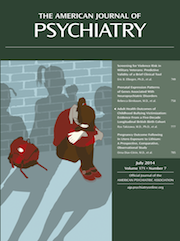Prenatal Expression Patterns of Genes Associated With Neuropsychiatric Disorders
Abstract
Objective
Neurodevelopmental disorders presumably involve events that occur during brain development. The authors hypothesized that neuropsychiatric disorders considered to be developmental in etiology are associated with susceptibility genes that are relatively upregulated during fetal life (i.e., differentially expressed).
Method
The authors investigated the presence of prenatal expression enrichment of susceptibility genes systematically, as composite gene sets associated with six neuropsychiatric disorders in the microarray-based “BrainCloud” dorsolateral prefrontal cortex transcriptome.
Results
Using a fetal/postnatal log2-fold change threshold of 0.5, genes associated with syndromic neurodevelopmental disorders (N=31 genes, p=3.37×10–3), intellectual disability (N=88 genes, p=5.53×10–3), and autism spectrum disorder (N=242 genes, p=3.45×10–4) were relatively enriched in prenatal transcript abundance, compared with the overall transcriptome. Genes associated with schizophrenia by genome-wide association studies were not preferentially fetally expressed (N=106 genes, p=0.46), nor were genes associated with schizophrenia by exome sequencing (N=212 genes, p=0.21), but specific genes within copy-number variant regions associated with schizophrenia were relatively enriched in prenatal transcript abundance, and genes associated with schizophrenia by meta-analysis were functionally enriched for some neurodevelopmental processes. In contrast, genes associated with neurodegenerative disorders were significantly underexpressed during fetal life (N=46 genes, p=1.67×10–3).
Conclusions
The authors found evidence for relative prenatal enrichment of putative susceptibility genes for syndromic neurodevelopmental disorders, intellectual disability, and autism spectrum disorder. Future transcriptome-level association studies should evaluate regions other than the dorsolateral prefrontal cortex, at other time points, and incorporate further RNA sequencing analyses.



